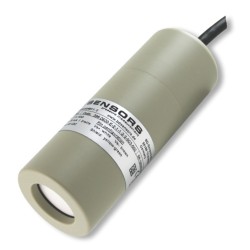
A disinfection systems integrator required a robust level sensor for a 1.5-meter-deep chemical tank. The application was challenging due to the highly aggressive media, either 13% Sodium Hypochlorite or 35% Sodium Hydroxide, and a high specific gravity of 1.5. A plastic submersible transmitter with a flush ceramic sensor was selected, featuring specially chosen wetted materials to ensure chemical compatibility and accurate measurement of the high-density liquid.
- Aggressive Media: Required a solution resistant to both Sodium Hypochlorite and Sodium Hydroxide.
- High Density: A 1.5m deep tank with a 1.5 SG liquid required a measurement range of at least 2.25 mH2O.
- Solution: An LMK 809 plastic transmitter with a flush Al2O3 ceramic sensor, PP-HT body, EPDM seals, and an FEP cable jacket.
A company specializing in disinfection systems required a continuous level monitoring solution for a chemical dosing tank. The tank itself was 1.5 meters deep, but the application presented two significant technical challenges that ruled out standard sensor configurations.
The first challenge was the aggressive and variable nature of the media. The sensor would need to be chemically robust enough to handle two different liquids: 13% Sodium Hypochlorite (NaOCl, bleach) and 35% Sodium Hydroxide (NaOH, caustic soda). The second challenge was the high density of the liquid. The customer specified a worst-case scenario where the media could have a specific gravity of 1.5, which is 50% denser than water. This high density meant that a simple 1.5-meter sensor would not be sufficient. The actual required pressure range was calculated to be 2.25 meters of water column (mH2O) to accurately compensate for the heavier liquid (1.5 m depth x 1.5 SG).
The proposed solution was a plastic submersible level transmitter from the LMK 809 series, specifically configured to meet these demanding requirements. To handle the aggressive media, a comprehensive review of chemical compatibility was undertaken. The standard PP-HT (Polypropylene) housing was selected for its inherent resistance to a wide range of chemicals. For the wetted seals, EPDM was chosen over FKM, as EPDM offers good compatibility with both Sodium Hypochlorite and Sodium Hydroxide, whereas FKM has poor resistance to Sodium Hydroxide. Furthermore, the standard PUR cable jacket was identified as incompatible with Sodium Hypochlorite. It was replaced with a specialized FEP cable, a material known for its high chemical inertness, ensuring long-term integrity of the cable assembly.
The sensor technology itself was a critical advantage for this application. The LMK 809 series features a high-purity 99.9% Al2O3 ceramic diaphragm. This capacitive ceramic sensor is not only extremely resistant to chemical attack but is also flush-mounted. This flush design is a key benefit, eliminating any recess where the chemicals, which can be viscous or contain impurities, could build up or crystallize. This feature significantly improves the reliability and long-term stability of the measurement by preventing clogging.
To address the customer’s high-density measurement requirement, a standard nominal range of 2.5 mH2O was selected. This range comfortably covers the calculated 2.25 mH2O requirement, ensuring the sensor operates well within its calibrated span. The transmitter provides a standard 4-20mA, 2-wire output signal, allowing for easy integration with the disinfection system’s central controls.

LMK809 Submersible Chemical Resistant Flush Diaphragm Level Sensor
- SKU ID: s1-lmk809-0015
- Part No: 396-2500-R-C-1-3-3-3-010-000
- Pressure Range: 0 to 2.5 mH2O g
- Reference Type: Gauge / Vented (atm to +P)
- Output Signal: 4-20mA, 2 wire
- Accuracy: 0.35% FS
- Installation Type: Submersible probe with flush diaphragm
- Housing Material: PP-HT
- Diaphragm Material: Ceramic Al2O3 99.9%
- Media Exposed Seals: EPDM
- Cable Type: FEP (70degC max)
- Cable Length: 10
- Cable Length Units: Metres (m)
